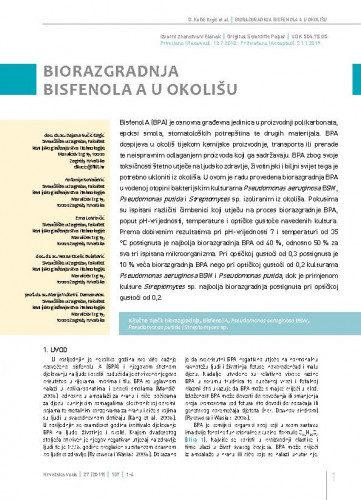Bisfenol A (BPA) je osnovna građevna jedinica u proizvodnji polikarbonata, epoksi smola, stomatoloških potrepština te drugih materijala. BPA dospijeva u okoliš tijekom kemijske proizvodnje, transporta ili prerade te neispravnim odlaganjem proizvoda koji ga sadržavaju. BPA zbog svoje toksičnosti štetno utječe na ljudsko zdravlje, životinjski i biljni svijet te ga je potrebno ukloniti iz okoliša. U ovom je radu provedena biorazgradnja BPA u vodenoj otopini bakterijskim kulturama Pseudomonas aeruginosa BSW, Pseudomonas putida i Streptomyces sp. izoliranim iz okoliša. Pokusima su ispitani različiti čimbenici koji utječu na proces biorazgradnje BPA, poput pH-vrijednosti, temperature i optičke gustoće navedenih kultura. Prema dobivenim rezultatima pri pH-vrijednosti 7 i temperaturi od 35 °C postignuta je najbolja biorazgradnja BPA od 40 %, odnosno 50 % za sva tri ispitana mikroorganizma. Pri optičkoj gustoći od 0,3 postignuta je 10 % veća biorazgradnja BPA nego pri optičkoj gustoći od 0,2 kulturama Pseudomonas aeruginosa BSW i Pseudomonas putida, dok je primjenom kulture Streptomyces sp. najbolja biorazgradnja postignuta pri optičkoj gustoći od 0,2..; Bisphenol A (BPA) is the basic building block in the production of polycarbonates, epoxy resins, dental products and other materials. BPA enters the environment during the chemical production, transport, processing or inadequate disposal of the product containing it. Because of its toxicity, BPA has an adverse impact on human health as well as animal and plant life, and has to be removed from the environment. In this paper, the biodegradation of BPA took place in the aqueous solution containing bacterial cultures of Pseudomonas aeruginosa BSW, Pseudomonas putida and Streptomyces sp. isolated from the environment. Various factors affecting the BPA biodegradation process, such as pH value, temperature, and optical density of the mentioned cultures were tested. According to the obtained results, the best BPA biodegradation of 40% i.e. 50% was achieved at pH value of 7 and temperature of 35° C for all three tested microorganisms. At optical density of 0.3, 10% higher BPA biodegradation was achieved with cultures Pseudomonas aeruginosa BSW and Pseudomonas putida than at optical density of 0.2 whereas the use of the culture Streptomyces sp. resulted in the best biodegradation at optical density of 0.2.
Sažetak
